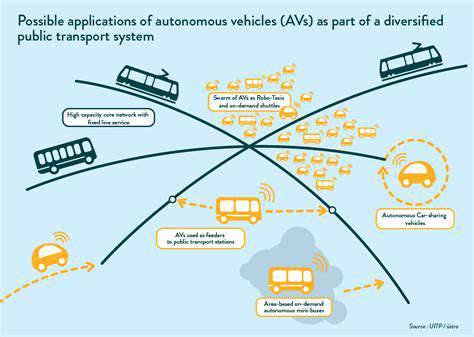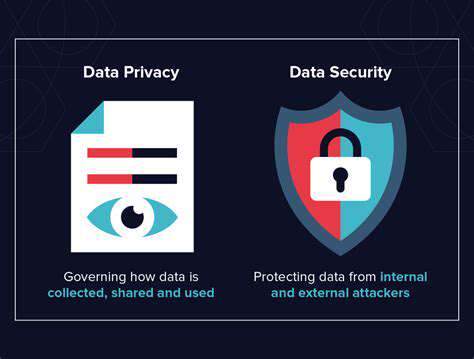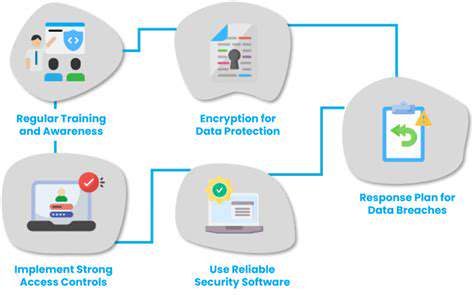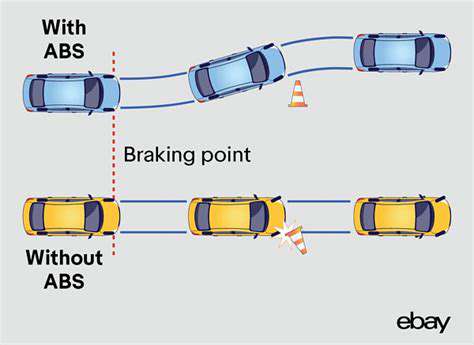Legal and Regulatory Frameworks: Defining the Rules of the Road
Navigating the Legal Landscape for Self-Driving Cars
Autonomous vehicles (AVs) are rapidly evolving, but their integration into society requires a robust legal framework. This framework must address liability in case of accidents, define the roles and responsibilities of various parties involved (vehicle manufacturers, owners, and operators), and establish clear guidelines for the operation of these complex systems. Current legal systems, largely developed for human-driven vehicles, face significant challenges in adapting to the unique characteristics of autonomous driving, including the degree of automation and the potential for malfunctions or unforeseen circumstances.
Liability and Responsibility in Accidents Involving AVs
Determining liability in an accident involving an autonomous vehicle is a complex legal issue. Who is responsible – the vehicle manufacturer, the software developer, the owner, or the operator? Current legal frameworks, which often focus on negligence and fault, may not adequately address the unique dynamics of autonomous systems. Finding a balance between protecting consumers and ensuring accountability is crucial for the responsible development and deployment of AV technology.
Regulatory Harmonization Across Jurisdictions
The development and deployment of autonomous vehicles require a unified approach across different jurisdictions. Lack of harmonization in regulatory frameworks can create significant obstacles for AV companies seeking to operate in multiple markets. Different standards for testing, certification, and operation can hinder the adoption of AV technology and limit the potential for its widespread use. This requires international collaborations and shared best practices to develop a globally consistent legal framework for autonomous driving.
Data Privacy and Security in AV Systems
Autonomous vehicles collect and process vast amounts of data, raising significant concerns about privacy and security. This data, which includes location information, driving habits, and potentially personal details, must be protected from unauthorized access and misuse. Robust data protection measures and clear guidelines for data handling are essential to build public trust and prevent potential abuses. Establishing clear legal boundaries around data collection and usage is crucial in the development of a responsible AV ecosystem.
Ethical Considerations in Autonomous Vehicle Design
Autonomous vehicle systems must be programmed to handle ethical dilemmas, such as choosing between different courses of action in an accident. The development and implementation of ethical guidelines and decision-making algorithms that prioritize safety, minimize harm, and align with societal values are crucial. These considerations extend beyond the technical aspects of the technology and require input from ethicists, philosophers, and policymakers to ensure that AV systems prioritize human well-being.
The Role of Human Oversight and Intervention in AVs
While autonomous vehicles aim for complete self-sufficiency, the need for human oversight and intervention in certain situations remains. This includes situations like unexpected events or malfunctions of the system. Regulations must clearly define the conditions under which human intervention is necessary and the responsibilities of both the human operator and the autonomous system. Balancing the benefits of autonomy with the need for human oversight is a critical aspect of developing a safe and effective legal framework for autonomous driving.
Infrastructure Adaptation: Paving the Way for Autonomous Vehicles

Adapting to Changing Needs
Infrastructure projects, whether for transportation, utilities, or communication, must be designed with a long-term perspective. Anticipating future demands and potential disruptions, like climate change impacts or population growth, is crucial. This proactive approach ensures that investments in infrastructure are resilient and meet evolving societal needs, preventing costly and time-consuming replacements or upgrades later. Planning must consider potential shifts in energy sources and technologies, so that the infrastructure can adapt to them.
Climate Change Considerations
Climate change presents significant challenges to existing infrastructure, demanding careful adaptation strategies. Rising sea levels, increased frequency and intensity of extreme weather events, and changes in precipitation patterns all necessitate adjustments to current designs and construction practices. For example, coastal infrastructure must be elevated or reinforced to withstand storm surges, and drainage systems need to be upgraded to handle heavier rainfall. This adaptation process must be integral to project planning, not an afterthought.
Technological Advancements
Technological advancements play a vital role in infrastructure adaptation. Innovations in materials science, construction techniques, and energy efficiency are transforming how infrastructure is designed, built, and maintained. These advancements allow for the creation of more sustainable and resilient infrastructure, reducing long-term costs and environmental impact. Improved sensors and data analysis techniques can also enhance monitoring and maintenance, enabling proactive problem identification and resolution.
Sustainable Materials and Practices
Employing sustainable materials and construction practices is essential for long-term infrastructure adaptation. This involves using recycled materials, prioritizing locally sourced materials, and adopting environmentally friendly construction methods. These practices not only reduce the environmental footprint of infrastructure projects but also contribute to a more resilient and sustainable future. Using renewable energy sources for powering infrastructure systems is also a key part of this approach.
Economic Viability and Funding
The economic viability of infrastructure adaptation projects must be carefully considered. Assessing the costs and benefits over the project's lifespan is crucial to ensure that the investment is worthwhile. This includes considering potential savings from reduced maintenance, increased efficiency, and avoided disruptions. Adequate funding mechanisms are essential for implementing adaptation strategies, potentially requiring public-private partnerships or innovative financing models. These mechanisms must also factor in the long-term implications of the projects, not just the immediate costs.
Community Engagement and Equity
Infrastructure adaptation projects must consider the needs and perspectives of the communities they impact. Engaging with local residents, businesses, and stakeholders is crucial to ensure that projects are equitable and address community concerns. This includes incorporating community feedback into the design process and ensuring that the benefits of adaptation are distributed fairly. Careful attention to social equity is critical, as not all communities are equally vulnerable to infrastructure failures, and adaptation plans must reflect this.
The automotive landscape is undergoing a radical transformation with the emergence of self-driving cars. These technological marvels combine cutting-edge sensors, complex decision-making algorithms, and powerful computational systems to redefine personal mobility. Modern autonomous systems are achieving unprecedented levels of sophistication, with continuous advancements in lidar precision, machine learning models, and real-time processing capabilities pushing the boundaries of what's possible.
Ethical Considerations: Navigating the Moral Dilemmas

Transparency and Honesty
Maintaining transparency in all aspects of the process is paramount. This includes clearly outlining the objectives, methods, and potential limitations of any research or project. Failure to be upfront about these details can erode trust and damage the reputation of individuals and institutions involved. Open communication fosters a more ethical environment where stakeholders can make informed decisions.
Respect for Individuals and Communities
Ethical considerations demand a deep respect for the dignity and rights of all individuals and communities involved. This means ensuring that no one is exploited, coerced, or otherwise harmed in the pursuit of knowledge or goals. Protecting vulnerable populations is particularly crucial, requiring careful consideration of their unique needs and sensitivities. Active engagement and collaboration with affected communities are essential to ensure their voices are heard and their concerns are addressed.
Confidentiality and Privacy
Protecting the privacy and confidentiality of sensitive information is critical. This includes safeguarding personal data, research findings, and other confidential materials. Strict adherence to data protection regulations and ethical guidelines is essential to maintain trust and prevent harm. Anonymity and pseudonymity measures should be implemented where appropriate to ensure the protection of individuals and their identities.
Avoiding Bias and Discrimination
Research and projects must be designed and implemented in a way that avoids bias and discrimination. This includes acknowledging and addressing potential biases in methodologies and ensuring that all participants are treated fairly and equitably. Promoting diversity and inclusion in research teams and participant selection is essential to produce more accurate and reliable results and to ensure that diverse perspectives are represented.
Accountability and Responsibility
Individuals and institutions involved in any project or endeavor must accept accountability for their actions. This encompasses the need to uphold ethical standards and to address any ethical concerns promptly. Transparency and a willingness to engage in constructive dialogue are crucial components of accountability. This is equally important for individuals and institutions, from researchers to the organizations they represent.
Beneficence and Non-Maleficence
The principle of beneficence requires that projects strive to maximize benefits and minimize potential harms. This includes carefully evaluating the potential risks and benefits of any action and taking steps to mitigate negative consequences. Prioritizing the well-being of all stakeholders is paramount to ethical decision-making. A thorough assessment of potential risks and mitigation strategies should be a component of any ethical review process.
Justice and Fairness
Ethical considerations require a commitment to fairness and justice. This involves ensuring that the benefits and burdens of any project are distributed equitably and that all stakeholders have equal access to resources and opportunities. This includes considering the potential impact on different groups and ensuring that the outcomes are just and equitable for all. Addressing potential disparities and power imbalances is essential to achieving a just and equitable outcome.
Economic Implications and Social Impact: Rethinking the Future of Mobility
Autonomous Vehicles and Economic Growth
The widespread adoption of autonomous vehicles promises a significant boost to economic output. Reduced traffic congestion, optimized logistics, and increased labor productivity in various sectors are potential benefits. This increased efficiency could translate to lower transportation costs for businesses and consumers, leading to a more competitive market and potentially stimulating economic growth across the board. Furthermore, new industries related to autonomous vehicle technology, such as software development, sensor production, and infrastructure upgrades, will emerge, creating new job opportunities and driving innovation.
Impact on Urban Planning and Infrastructure
Autonomous vehicles necessitate a re-evaluation of urban planning and infrastructure development. The need for extensive charging infrastructure, specialized roadways, and potentially altered zoning regulations will demand significant investment and strategic planning. Cities will need to adapt to the potential changes in traffic patterns and land use, creating opportunities for innovative urban design that prioritizes pedestrian and cyclist safety and accessibility. This reimagining of urban spaces will also affect the future of public transportation and its role in the overall mobility ecosystem.
Social Implications and the Future of Work
The transition to autonomous vehicles will undoubtedly affect the job market. Drivers, particularly those in trucking and ride-hailing services, may face unemployment or career shifts. However, new jobs will emerge in areas like autonomous vehicle maintenance, software engineering, and data analysis. The social implications extend beyond the job market, affecting the accessibility of transportation for individuals with disabilities or limited mobility, and potentially fostering a more equitable and efficient transportation system for all.
Changes in Transportation Costs and Accessibility
Autonomous vehicles have the potential to revolutionize transportation costs. Reduced congestion and optimized routes could lead to significant savings for businesses and individuals. This could have a ripple effect throughout the economy, potentially lowering the cost of goods and services. Furthermore, autonomous vehicles could increase accessibility for individuals who currently face challenges in accessing transportation, such as the elderly, people with disabilities, and those in rural areas.
The Role of Government Regulation and Policy
Effective government regulation and policy will be crucial to navigating the transition to autonomous vehicles. This includes establishing safety standards, addressing liability issues in accidents, and formulating policies that promote competition and innovation within the industry. Clear legal frameworks are essential to foster trust and encourage investment in the technology. Government intervention will play a key role in ensuring a smooth and equitable transition for society.
Ethical Considerations and Societal Impacts
Autonomous vehicles raise complex ethical dilemmas. Who is responsible in the event of an accident? How can we ensure equitable access to this technology? These are just a few of the ethical considerations that need careful consideration. Beyond the immediate practical implications, there are also broader societal impacts to consider, such as the potential for increased social isolation or changes in social interactions due to the shift in how people travel. These issues require ongoing discussion and debate to ensure a responsible and equitable transition to the future of mobility.











